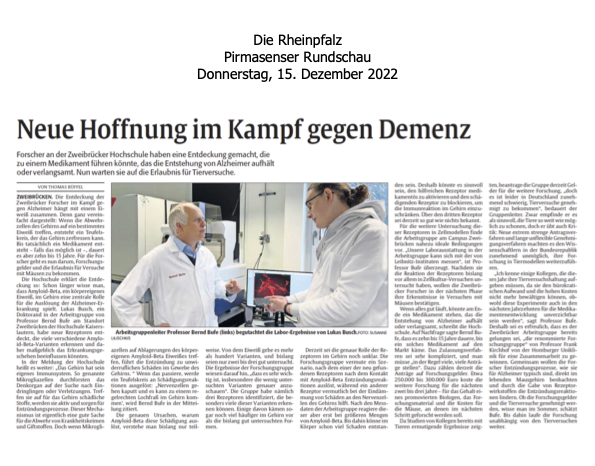It has long been known that amyloid beta, a protein produced naturally in the body, plays a central role in triggering Alzheimer’s disease in the brain. Lukas Busch, a doctoral student in Prof. Dr. Bernd Bufe’s working group at the Zweibrücken site of Kaiserslautern University of Applied Sciences, has discovered new receptors that recognize many different amyloid beta variants and could therefore significantly influence the course of the disease.
The brain has its own immune system. So-called microglial cells scour the thinking organ in search of intruders or injuries. When they encounter substances that are harmful to the brain, they become active and trigger inflammatory processes. This mechanism is actually a good thing for the defense against germs and toxins. However, when microglial cells encounter deposits of the body’s own amyloid beta protein, the inflammation leads to irreversible damage in the brain tissue. “When this happens, a vicious circle of damage reactions is triggered. Nerve cells are damaged and this can lead to a veritable pitting of the brain,” says Prof. Dr. Bernd Bufe, explaining the process. The exact reasons why amyloid beta triggers this damage are still only partially understood. There are more than a hundred variants of amyloid beta, of which only two to three have been well studied to date. “Our results indicate that it is very important to take a closer look at the less studied variants in particular,” notes the research group leader. The research group has identified three receptors that can recognize a particularly large number of these variants. Some of these are even more common in the brain than the previously well-studied forms. At present, the exact role of the receptors in the brain is still unclear. The research group hypothesized the following scenario, in which one of the newly found receptors (FPR1) triggers inflammatory reactions after contact with amyloid beta, while another receptor (FPR2) presumably helps to contain damage to the brain’s nerve cells. Unfortunately, according to the working group’s measurement data, this only reacts with larger quantities of amyloid beta, so a lot of damage may have already occurred in the body beforehand. It could therefore make sense to activate the helpful receptor with medication and block the harmful receptor in order to restrict the immune reaction in the brain. Virtually nothing is currently known about the third receptor (FPR3). Since it does not occur in the brain, it can only be involved in Alzheimer’s in the late stages of the disease. For the further investigation of these receptors in cell models, the working group at the Zweibrücken site of Kaiserslautern University of Applied Sciences has almost ideal conditions for such work. “Our laboratory equipment in the working group can compete with that of Leibnitz Institutes,” Prof. Dr. Bufe is convinced. Doctoral student Lukas Busch also studied here. “The Applied Life Sciences course at Kaiserslautern University of Applied Sciences is extremely modern and prepares you for many professional fields. My fellow students are now working for renowned companies such as Biontech and Boehringer.” For this reason, the Zweibrücken researchers have so far mainly investigated the reaction of the receptors in cell culture experiments. In the next phase of their research project, they will primarily try to confirm their findings in mouse models. If all goes well, we could end up with a drug that stops or slows down the development of Alzheimer’s disease. “Studies by colleagues are already showing encouraging results in animal models. That’s why we are currently applying for funding for further research,” explains Prof. Dr. Bufe, “but unfortunately it is increasingly difficult to get animal experiments approved in Germany.” Of course, he feels it makes sense to protect animals as much as possible, but new, extremely strict application procedures and long, inflexible approval processes are making it increasingly impossible for scientists in Germany to continue their research in animal models. “” I know some colleagues who will have to give up their animal experiments this year because they can no longer cope with the bureaucratic effort and high costs, although these experiments will continue to be indispensable for drug development in the coming decades,” says Prof. Bufe. It is therefore gratifying that the working group has already succeeded in winning the renowned research group of Prof. Dr. Frank Kirchhof from the University Hospital Homburg/Saar for a collaboration. Together they plan to observe inflammatory processes typical of Alzheimer’s directly in the living mouse brain and to alleviate the inflammatory reactions by administering receptor substances.

